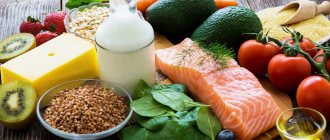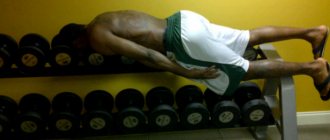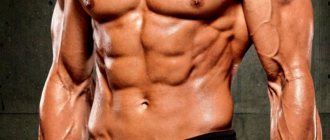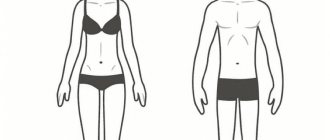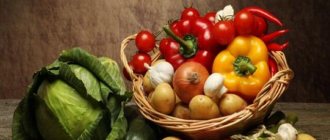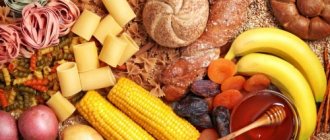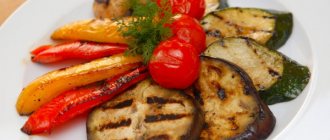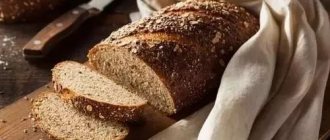Proper nutrition for an athlete is as important as regular training. The food you eat affects muscle growth, post-workout recovery, and overall health of the body.
In this material we will talk in detail about all the nuances of sports nutrition. You will learn what is its fundamental difference from regular nutrition, what foods you need to eat and which should be excluded from your diet. You will also find standard menus for different purposes and learn about the importance of balancing proteins, fats and carbohydrates.
Basic concepts and principles, how it differs from regular nutrition
Any professional athlete will tell you that without proper nutrition it is almost impossible to achieve high results. There is logic in this - during training, the body spends a huge amount of energy, which must be replenished, including through food. The correct balance of vitamins and microelements helps the body recover faster after exercise.
Any sports diet includes a preliminary calculation of BZHU - proteins, fats and carbohydrates. Different diet goals imply different ratios of dietary fatty acids in the foods consumed. There are three main requirements that sports nutrition must meet:
- Enriching the body with vitamins and microelements;
- Normalization of exchange processes;
- Normalization and subsequent maintenance of body weight.
Preparing a diet begins with calculating the dietary supplements needed by the body. Products and meals are selected in such a way that the athlete receives the required amount of calories. WHO standards for the BJU ratio: 1:1:4.
If the goal is to lose weight, the amount of protein is kept to a minimum. If a person wants to gain muscle mass, then proteins in food should prevail. The World Health Organization has derived and presented the basic principles on which an athlete’s diet is based:
- 300-500 grams of vegetables and fruits every day;
- Since fruits are quickly digested, it is best to consume them 30-60 minutes before the main meal;
- It is not recommended to eat fried foods. The omega-3,6,9 contained in it is transformed into toxic substances;
- Do not overuse salt and sugar, maximum 10% of the daily value;
- In the first half of the day, it is necessary to focus on the consumption of complex carbohydrates and foods saturated with fats;
- The last meal is no later than 3 hours before bedtime;
- Root vegetables with high starch content
Nutrition Basics for Athletes
There is no universal diet that is equally suitable for a weightlifter and a Tour de France participant. It is necessary to take into account the type of sport, load, characteristics of your own complexion and metabolism. Among amateur athletes and beginners who come to sports for the sake of an elegant figure, there is an opinion that athletes eat little. This is not true: athletes eat not little, not much, but as much as they need. Alpha and omega of a sports diet - a sufficient amount of calories that can compensate for energy losses. Athletes have significant energy losses: a skinny Tour de France participant most likely eats much more than your obese neighbor down the stairs, because a Tour de France participant needs tens of times more energy.
Despite the fact that there is no universal diet, the basic principles of sports nutrition can be identified:
- There should be enough calories for the planned exercise.
- The diet needs to balance proteins, carbohydrates and fats; none of the components can be completely excluded.
- Food should be rich in vitamins and microelements.
- Despite point 3, you need to take additional vitamins and biological supplements.
- The diet is planned taking into account the goals: reduce, increase body weight, maintain weight stable.
- Despite point 5, the menu is in any case designed to help reduce fat tissue and increase muscle tissue.
- We must not forget about water - its lack leads to muscle fatigue and harms joints.
- You need to eat in small portions, but often.
Which products should be more common and contain which substances?
The three main components should be found in products in the following proportions:
- Proteins – about 30-35%;
- Fats – about 10-20%;
- Carbohydrates – about 50-60%;
The menu is compiled individually, depending on gender, age, health, and physical fitness.
Squirrels
An athlete's menu must include foods containing proteins: slowly and quickly digestible. They consist of amino acids, proteins and peptides that strengthen and catalyze the growth of muscle tissue.
Daily protein intake should be in the range of 10-25 grams per 10 kg of body weight. For an average person weighing 75 kilograms, 150 grams of protein per day will be enough.
If the athlete’s goal is to gain weight, you need to increase the amount of protein consumed by switching to a special protein diet, or simply changing the diet with the addition of protein dishes.
Fats
A balanced diet should include healthy fats. The body spends them during cardio training - monotonous activities at a low pace. Fats also act as a temperature regulator in the body and support the functioning of internal organs.
Fats are divided into two types: vegetable and animal. It is important that both are present in the diet. There should be 1-2 grams of fat per kilogram of weight.
Carbohydrates
Biologically active substances that are the main metabolic processes in the body. Carbohydrates are responsible for energy and recovery. A proper diet should include both simple and complex carbohydrates.
For 1 kilogram of your own weight per day you need to consume from 5 to 10 g of carbohydrates. On average, a person weighing 80 kg will consume about 60-70 grams. It is recommended to consume complex carbohydrates in the first half of the day, before 14:00.
The process of breaking down starch in the body provides us with glucose, which is directly related to the replenishment of energy and vitality. Starch is a good source of complex carbohydrates. By eating carbohydrates at breakfast, you will be full of energy for the whole day. It is for this reason that you should not skip breakfast.
Sports nutrition for weight loss
The need to lose weight may appear before competitions, in order to qualify for the desired weight category, for beginners at the beginning of their sports journey. A sports diet for weight loss is also used before the “drying” process.
The main objective of such a diet is to provide the athlete with a sufficient amount of protein in a low-calorie diet. You need to calculate your daily calorie intake for burning fat yourself. To do this, you will need to calculate the formula that we discussed above, and the resulting figure should be multiplied by 0.8. The results of such an equation will be the required number of calories individually for women and men.
To lose weight faster, you can reduce your calorie intake even more, but only under the supervision of a nutritionist. Healthy nutrition experts believe that men should not reduce their caloric intake to less than 1800 kcal, and for women this figure is 1200 kcal.
Too critical dietary restrictions are strictly prohibited.
Diet rules and a set of products are characteristic of a healthy lifestyle. You should give up everything that is not beneficial and can be dangerous to your health. In the first half of the day, slow carbohydrates are relied upon; after training and for dinner, proteins are required. Almost 70% of the total amount of food should be consumed before 16:00, as the body absorbs nutrients faster during the day.
It is advisable that the menu for the week consist of low-calorie days and one fasting day. From time to time it is recommended to resort to roller coasters, which can be extremely useful for weight loss. For a clear example, consider such a menu for 7 days with “female” calorie content.
First day
Breakfast: carrot and seaweed salad, tea.
Lunch: sweet and sour apple.
Lunch: cream of broccoli and chicken soup, rye crackers.
Afternoon snack: fermented baked milk with a handful of blueberries.
Dinner: oatmeal with water, boiled egg and lettuce salad.
Second day
Breakfast: boiled brown rice, sweet peppers, plain coffee.
Lunch: grapefruit.
Lunch: lean borscht, a little sour cream, toast.
Afternoon snack: a handful of dried apricots, chamomile tea.
Dinner: zucchini and carrot stew with rabbit.
The third day
Breakfast: millet porridge with pumpkin, tea.
Lunch: skim milk.
Lunch: pickle without potatoes, bran toast.
Afternoon snack: peanuts, mineral water.
Dinner: steamed pike perch, berry compote.
Fourth day
Breakfast: omelet with mushrooms, black coffee.
Lunch: kefir.
Lunch: soup with barley and vegetables.
Afternoon snack: sweet and sour apple.
Dinner: cottage cheese casserole with tomatoes.
Fifth day
Breakfast: tea, sandwiches with chicken breast and lettuce.
Lunch: orange.
Lunch: fish broth without potatoes, rye bread.
Afternoon snack: hard cheese with linden tea.
Dinner: stewed green beans, boiled veal.
Day six – fasting: you can use kefir, Greek yogurt, a mono-diet of vegetables or fruits.
Seventh day
Breakfast: soft-boiled eggs, vegetable salad.
Lunch: two kiwis, mineral water.
Lunch: mushroom soup, natural crackers.
Afternoon snack: prunes, tea.
Dinner: unsweetened oatmeal, a piece of boiled fish.
The menu for men should be more expanded, contain more protein and a little more animal fat. It is still forbidden to add salt to food, and it is better to add honey to drinks if you don’t like them at all without sugar.
A fat burning diet should be accompanied by strength training. Gaining muscle mass can mask the real results of weight loss, so your scale readings may even increase. With proper weight loss, you should lose 2-4 kilograms per month. Beginners, after achieving the desired result, need to switch to a diet to maintain physical fitness or gain muscle mass. Depending on your goals, a weight loss diet will last from a week to several months.
Products for a healthy diet
You'll have to sacrifice some of your favorite treats if you want to get your body in good physical shape. Below is a list of products that are recommended for consumption:
- Poultry: chicken, turkey. It contains a lot of proteins and vitamins;
- Cereals, oatmeal. Contains fiber, vitamins and minerals;
- Red sea fish. Contains omega-3 fatty acids necessary for the body, accelerates metabolic processes;
- Beef is a source of BJU;
- Buckwheat grain. Rich in starch, a complex carbohydrate that provides the body with energy;
- Chicken eggs - rich in zinc, iron, protein;
- Clean drinking water. It is necessary to drink at least two liters a day for the body to work at full strength;
- Fruits and vegetables are sources of vitamins and microelements;
- Low-fat yoghurts, sour cream, kefir, cheeses;
Diet features
Athletes' nutrition varies depending on their body type. Its calorie needs, as well as the proportions of its diet, depend on this.
For people with different body types
All people, regardless of gender, are divided into the following groups:
- a mesomorph with an athletic build needs to maintain optimal weight;
- ectomorph, prone to thinness, needs to gain weight;
- an endomorph prone to obesity needs to lose weight.
Each of these types must follow specific nutritional guidelines.
| Body type | Mesomorph (increase in calories) | Ectomorph (increase in calories) | Endomorph (calorie reduction) |
| Diet proportions |
|
|
|
| Recommended Products |
|
|
|
| Nutrition tips | Consumption of fish oil, flaxseed oil, nuts. | Increase calorie content by 500-600 kcal. | Avoid eating simple carbohydrates. |
The table presents the basic rules of nutrition by body type, depending on the goals of sports activities.
For gaining muscle mass
People belonging to the mesomorphic and ectomorphic types, during sports activities, need to gain body weight due to the increase in muscle tissue. They need to increase their caloric intake by consuming proteins, fats and carbohydrates in strict proportions.
Recommendations for adjusting nutrition for these types are presented in the general table above. It provides recommendations on how much to increase your intake of proteins, fats and carbohydrates.
For weight loss and burning subcutaneous fat
Endomorphs, who, as a rule, have excess body weight, need its qualitative reduction, which will occur due to fat, not muscle tissue. People with a similar body structure need to reduce their overall caloric intake. Read more about nutrition for an endomorph in our article.
The proportions of reducing the consumption of proteins, fats and carbohydrates are given as percentages in the table. It also provides recommendations for choosing products for people with an endomorphic body type.
Proper nutrition and exercise give amazing results for endomorphs when losing weight. At the same time, it is the balance of substances in the diet that is important with a general reduction in caloric content of food. To further stimulate fat burning, protein and other diets are used.
Depending on the body type, the consumption of certain products is regulated, the diet is adjusted, thus reducing or gaining body weight.
Read our article about creating a menu for fans of fitness nutrition for weight loss.
What happens if you don't stick to your diet?
Many people do not think about their diet at all, but poor nutrition can lead to sad consequences for the body. Moreover, poor nutrition means not just the consumption of fast food, but also large portions, lack of vitamins, and incorrect balance of nutritional supplements. What can poor nutrition lead to:
- Deep-fried foods contain many carcinogens. This can lead to the development of cancer;
- Excess salt and spices in foods gives them taste, but does not benefit the body. The risk of developing hypertension, kidney disease, and joint problems increases;
- An incorrect ratio of BZHU leads to a lack of minerals and nutrients in the body. You will feel hungry much more often than if you were eating healthy;
- Trans fats contained in foods negatively affect immunity and reproductive function. Trans fats include margarines and various spreads;
- Improper nutrition leads to obesity, stomach and intestinal diseases.
Main conclusions
A sports nutrition regimen during training requires strict adherence to the regimen.
When switching to a new diet, it is necessary to take into account both general and individual factors so as not to harm your health.
We should not forget about the drinking regime, as well as taking sufficient amounts of vitamins and minerals.
When switching to a new type of diet, it is necessary to consult with a specialist to develop an optimal diet, taking into account all individual characteristics.
What should the menu include?
Let's look at several basic menus for different types of people, depending on their goals. Each menu, depending on the purpose, has its own balance of food products and includes different products.
Sports menu
The optimal ratio of BZHU for an athlete:
- 30% – proteins;
- 60% – carbohydrates;
- 10% – fats.
A person involved in sports should consume about 2500-2700 kilocalories per day.
Products that will make up the athlete’s diet:
- Cereals;
- Skim cheese;
- Cereal porridge;
- Fruits and vegetables;
- Poultry meat;
- Bread;
It is better not to overuse salt and sugar, use olive oil when frying, and eat vegetables either fresh or steamed and stewed. It is better to eat fractionally, in small portions 4-5 times a day. You can eat fruits and dairy products as snacks.
Menu for a strength athlete
The main goal of such a menu will be to build muscle mass. To do this, you need to consume not only protein products, but also biologically active components - sports nutrition supplements.
Sample menu for the day:
- For breakfast you can eat a protein shake, rice with steamed vegetables and bread;
- Snack – protein bar, green tea;
- Lunch – baked potatoes with cheese, beef stew, vegetable salad;
- Pre-workout snack – protein shake, protein bar;
- Dinner – stewed meat or fish, buckwheat, rice, herbal tea, avocado;
- Late dinner – oatmeal, fresh orange juice.
Menu for cutting or losing weight
Diet for athletes is not only a way to gain weight, but also to lose weight. Products that are best consumed in this case:
- Sea fish;
- Chicken breast;
- Skim cheese;
- Rice;
- Grapefruit;
- Porridge on the water;
- Cauliflower or broccoli;
- Omelette;
- Boiled eggs.
Diet for a week
It is better if your diet is prepared by an experienced trainer and nutritionist who will take into account your goals, type of activity, body composition and daily calorie needs. Therefore, our specialists have developed a weekly menu for athletes with different calorie needs. We offer a balanced weekly diet for athletes:
Delivery of balanced nutrition | Weekly food delivery reviews | Diet business lunch | Detox juices with delivery Moscow | Mediterranean take-home menu | Complex for weight loss | Sports food delivered | Order vegetarian food to your home in Moscow
Example of breakfast, lunch and dinner
Balanced sports nutrition: breakfast, lunch and dinner. You can eat three times a day or split your food into 5-6 meals. The last option is the most optimal if you want to lose weight.
Breakfast
Option 1: oatmeal with water, banana, walnuts, green tea;
Option 2: two boiled eggs, whole grain bread, tomato, smoothie;
Option 3: Omelette of two eggs with vegetables, kefir;
Dinner
Option 1: boiled beef with rice, vegetable salad, freshly squeezed juice;
Option 2: turkey with buckwheat, tomato, banana, glass of mineral water;
Option 3: chicken broth, steamed fish, sliced vegetables, green tea;
Dinner
Option 1: turkey with rice, cheese soup, water;
Option 2: steamed fish, vegetable salad, kefir;
Option 3: seafood with garnish, vegetable broth, freshly squeezed juice.
What an athlete should not eat
Professional athletes have to give up some foods. Among them:
- Coffee. Many people drink cups of coffee, believing that it will give them energy and improve attention and concentration. Caffeine does provide energy, but only for a short period of time. After some time you will feel tired and exhausted. It is better to replace coffee with green tea;
- Sauces from stores. Ketchups, tartar, cheese and mustard sauces - all this is strictly prohibited. They contain many dyes, preservatives, sugar and other harmful substances;
- Salt and sugar are white death. Sugar can be replaced with natural honey, and salt with soy sauce, lemon juice or spices;
- Fast food contains dyes, preservatives, and carcinogens. It is not recommended to use it not only for athletes, but for everyone in general.
Dietary recommendations
Several useful recommendations that will help answer the question of how to eat properly for athletes.
- Create your own menu. There are many “magic” diets on the Internet, but none of them may be right for you. Study the necessary literature or consult a nutritionist;
To create your diet, you need to know your daily calorie intake. Here is a convenient calculator for calculation
- The standard distribution of BJU for professionals should be around 3:1:6;
- A sports diet should contain nutritious natural foods, without dyes or additives;
- Give preference to dark grains: brown rice, buckwheat;
- Use sports supplements with caution;
- Don't overeat or starve, there should be balance in food. You should feel full. Chew your food thoroughly while eating;
- During cutting and losing weight, the amount of calories consumed should be less than the amount received from food. Cardio exercise is a good way to lose weight. In a week of training at an average pace, you can lose about two kilograms;
Water manipulation
The fitness models and bodybuilders who perform on stage don't actually look like this all year round. It is nearly impossible (and also very unhealthy) to stay at an extremely low body fat percentage year-round (less than 5%). However, there is one more trick that allows them to look even drier than usual. Athletes strictly control their water intake to help their bodies appear even drier during competition.
By reducing water consumption, which is collected outside the muscles, they appear toned and increase vascularity and the number of grooves. Their bodies don't look smooth/bloated/swollen, but dry and defined.
Athletes achieve this by dramatically increasing their water intake about a week before competition. They usually drink up to 7.5 liters of water daily. This literally turns their bodies into human water fountains.
As the body becomes concerned about the amount of water consumed, as a self-defense mechanism, it begins to urinate very frequently in an attempt to lose water weight.
Approximately 24 hours before the start of the competition, the participant reduces water consumption. However, the bodybuilder's body will continue to flush out water, leaving it looking very dry. After 24 hours, the body realizes that the person is no longer drinking large volumes of water. As a result, the body begins to retain fluid again.
Such tricks with water create a visual illusion: a person looks much thinner compared to what he was a week ago. In fact, their body fat percentage remained about the same. And yet, thanks to this “water” manipulation, they look much drier.
